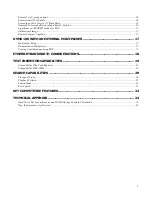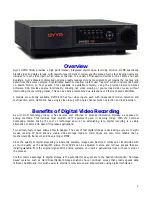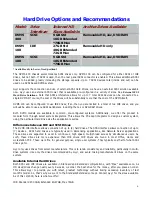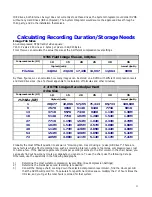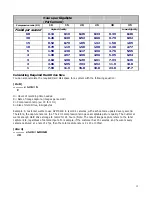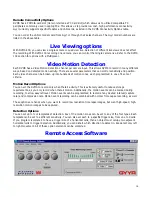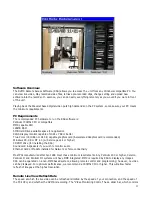
17
Significance of SEARCH mode over RAS
The Search function of DVMS is extremely powerful, allowing the user to easily identify and retrieve events based
on specific criteria. Very few, if any systems have this capability. This becomes particularly significant when the
remote connection is limited in transfer speed, like when using a modem. You might want to retrieve a 10MB clip
over a modem, but you probably don’t want to wait an hour to do so. DVMS and RAS allow you to make the most
efficient use of your connection, sending just the information you need and nothing more.
Authenticate Image
When playing downloaded video files, you can select
Action>Authenticate
from the main RAS menu. This
verifies that the video file is not altered in any way. To Authenticate, you need to enter the serial number of the
DVMS that it was recorded on, and the secret password for that same DVMS. The password is a unique 64 bit
private key generated for every DVMS. This can be given upon request to those seeking to authenticate the clip.
This key, along with the serial number, verifies the imbedded checksum. If the checksum matches, then the video
clip is judged unaltered and original. This authentication technique is commonly used to protect high security
data, and is one of the best ways to verify the origin and integrity of the video clip. Authentication will only work
on video files, not bmp still image files.
Remote Software Upgrade
Periodically Gyyr will have software updates to both DVMS models. This will come in the form of a small “.bin”
file. When connected via RAS, you can remotely Flash update the DVMS unit with the bin file. Neat!
DVMS 100 with an External Multiplexer
DVMS 100 can be used with virtually any new or existing Multiplexer. This is a convenient way to increase the
recorded cameras up to 16. DVMS 100 connects to a Mux just like a regular TLVCR, and the CCTV monitor
connects to the Mux as normal.
Multiplexer Setup
DVMS 100 has an option for quick setup, which is used to get the system up and running with a minimum of
programming. Basically, you select the Multiplexer brand (or generic), connect the Camera Switcher pulse and
you’re ready to go. In some cases you may need to specify the number of “lines of coding offset”, in order for
DVMS to properly maintain the integrity of the Multiplexer encoding format. This is the selection that allows us to
work with most Muxes.
Recommended Multiplexers
If you don’t intend on using RAS with the system, you can use just about any brand Mux. Once again, the DVMS
100 operates like a TLVCR, albeit with much faster access and image quality. If you do intend on using RAS with
the system, we only recommend the following Mux brands:
Gyyr DSP series, Duplex
Pelco Genex, Duplex
Javelin Duplex
The reason for this is RAS can only decode images originating from those manufacturer’s formats. If you use a
Mux not in that list, then RAS won’t allow specific camera viewing on playback.
Robot, Dedicated Micros and Ultrak Multiplexer compatibility should be available perhaps as early as May 2000.
Check with Gyyr at that time. Remember, you’ll be able to upgrade any older DVMS with this enhancement.
Viewing Considerations using RAS
When using DVMS 100 with any Multiplexer, there are some viewing limitations. The following chart identifies
what is and is not possible, depending on the configuration. Note the following requirements for RAS to be usable
with a DVMS 100/Mux System.

